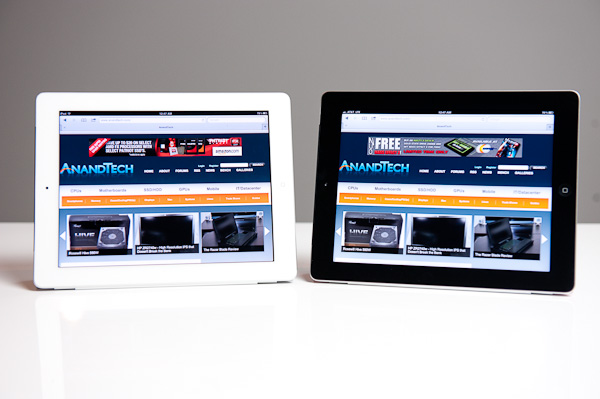The Apple iPad Review (2012)
by Vivek Gowri & Anand Lal Shimpi on March 28, 2012 3:14 PM ESTSince Apple launched the first iPad two years ago, the tablet market has evolved rapidly. While slate tablets were nothing new, the original iPad was the first serious tablet to be built around smartphone components and a user interface designed specifically for touchscreen input. The hardware was enough to run the OS smoothly while maintaining good battery life, the thin and light form factor lent itself to easy portability, and the touch-based user experience was miles better than earlier devices based on desktop operating systems.
We take it for granted now, but this was all news back in 2010, and the iPad was practically in a category of its own, with no real competitors to speak of. After Apple started shipping the iPad, the segment basically exploded—we had Google jump in with Honeycomb, HP got into it (and then out of it) with webOS, RIM had a go with the PlayBook, Amazon pushed the Kindle line into the tablet space, and Microsoft created its next release of Windows with tablets in mind. Along the way, Apple updated the iPad, both on the software side with multitasking, a new notifications system, and a myriad of UI updates, as well as launching second generation iPad hardware. The iPad 2 was a comprehensive update, bringing a dual core processor, unrivaled graphics performance, cameras fore and aft, and a ground up redesign that brought a thinner and lighter form factor.
The iPad 2 was a significant improvement over the original—faster, more portable, and generally a far more polished device. Not that it was perfect: iOS 4 still had issues with smooth multitasking and an archaic notifications system, the cameras were mediocre, and the XGA display, while a great quality panel, didn’t have the kind of pixel density expected of a premium mobile device. The iPad 2 hit market around the same time as Honeycomb (in Motorola’s Xoom) early last year, and at first Apple still held a major edge in terms of hardware. As more impressive Honeycomb devices like Samsung’s Galaxy Tab 10.1 and the ASUS Transformer Prime were launched, along with Ice Cream Sandwich looming on the horizon, Android became a much more viable tablet alternative to iOS. And with Microsoft planning for a major push later this year for ARM-based Windows 8 tablets centered around the Metro UI, Apple has never faced such stiff competition in the tablet space. Which brings us to the third generation of iPad hardware.
It has a display resolution that dwarfs most high-end desktop displays. The panel also puts a real emphasis on quality, not just resolution. For a computing device targeted squarely at the consumer market, both of these things are rarities.
Its SoC is the absolute largest ever squeezed into an ARM based tablet. The chip itself is even bigger than what you find in most mainstream notebooks. It’s expensive, it puts out a ton of heat and it offers a tremendous GPU performance advantage over anything else in its class.
And it has a battery that’s larger than what ships in the current crop of similarly sized ultraportables and Ultrabooks.
The new iPad doesn’t significantly change the tablet usage paradigm, but it does put all previous attempts at building hardware in this space to shame. It’s the sort of no holds barred, performance at any expense design that we’re used to seeing from enthusiast PC component vendors—but in a tablet...from Apple.
Welcome to the new iPad.












234 Comments
View All Comments
SixOfSeven - Thursday, March 29, 2012 - link
Any chance the glass is less likely to shatter on this one than on its predecessors?I didn't think so.
darkcrayon - Thursday, March 29, 2012 - link
The iPad 2's glass was much more resilient than that on the 1.. So who knows. I wonder if it's Gorilla Glass 2 and that's where a bit of weight savings came on the new iPad, considering the battery is so much larger yet the device is only slightly heavier.pdjblum - Thursday, March 29, 2012 - link
So you convinced yourself there is a use for it as it is "the world's greatest netbook" to your mind. Yet you can get a much more powerful intel notebook for about the same price or less. It is nothing more than an expensive indulgence. It is anything but enthusiast gear. Oh, I forgot, this has become another gadget site that loves crapple.kepler - Thursday, March 29, 2012 - link
That isn't true at all. Wait until you read the review for the Transformer Prime Infinity, it will be just as detailed, and I'm sure they'll like it just as much (or more) than the iPad3.I dislike Apple for a number of reasons, but I don't feel AnandTech has shown any bias.
darkcrayon - Thursday, March 29, 2012 - link
Not that you're anywhere close to reality, but I wonder why all these "gadget sites" seem to "love" Apple? Maybe because they make good products that people enjoy using? Naah, must be some hidden conspiracy. You're the one that knows the real deal, right?Everyone knows you can get a more powerful intel netbook for the same price. You can also get a more powerful intel netbook than smartphones which also cost more than the iPad. Oddly enough, you will not find an intel netbook on the market now with a screen anywhere near as nice as the iPad. Cool times we live in, eh?
doobydoo - Sunday, April 1, 2012 - link
Can you tell me which 'more powerful' intel notebook you can get which is capable of gaming at 2048 x 1536 at 60 fps and has a battery life over 9 hours, as well as being ultra-portable and light, instantly turns on, has a camera and built in 4G, at less than or the same price as the iPad?Good luck.
Lil Cheney - Thursday, March 29, 2012 - link
Wondering why as you review the A5x, you never use a Snapdragon chip for comparison, in addition to the Tegra 2 and 3?PeteH - Thursday, March 29, 2012 - link
Might be the lack of a shipping product to benchmark it against. The only performance numbers I've seen for an S4 came from Qualcomm's reference design.dagamer34 - Friday, March 30, 2012 - link
I'm actually not aware of any major tablets that use a Snapdragon chip. Most went with Tegra 2 early on, then moved to the OMAP 4 platform later in the year last year.siddharth7 - Thursday, March 29, 2012 - link
Well, the review is just amazing! Though its late than other sites, it was worth the wait. You went into so much of detail that I was just blown away. Photos are also great. Waiting for more reviews like this.Keep up the good work.
BTW, am I the only Indian commenting here expect the staff.
Thanks Anandtech.